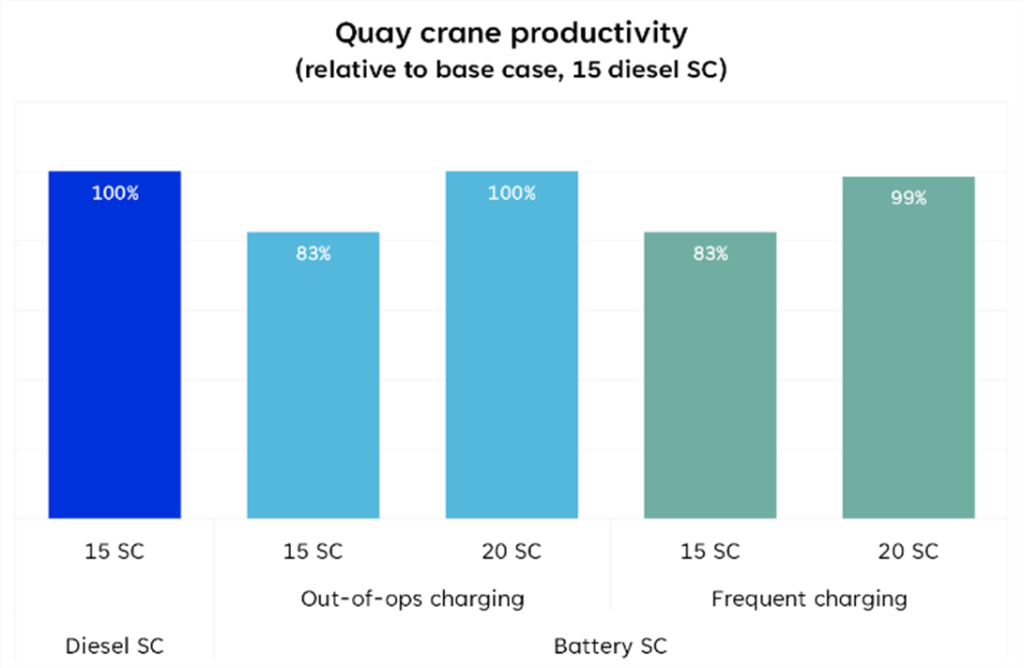The road to carbon zero is not just as simple as buying electric equipment
Becoming carbon neutral is one of the main challenges in the maritime industries for the next decades. To achieve that, electrifying equipment is surely an important path (if not the most relevant). (Besides, we strongly believe that improving operational efficiency would also contribute greatly to reduce energy consumption and in turn emission impact – see more via our recently published paper: saving energy at terminals).
It is clear and commonly acknowledged that the benefit of electrifying equipment on carbon emissions reduction is significant. While the industry has advanced and (more) matured on electrifying quay cranes and yard cranes, solutions for electrifying horizontal transport equipment are still being developed. From our talks to terminal planners, operators, and industrial vendors, many questions are still being raised such as:
- What is a good battery size for my operation?
- Should I consider battery charging or battery swap option?
- Should I adopt fast charging in my operation or only deep charging?
- How many chargers do I need and where do I locate them?
- Do I need to buy more equipment to allow for charging?
- Can I make use of shift-changes and operational breaks?
- Which software is “responsible” for charging equipment in time?
- What is economically the most attractive charging solution?
- What will be the impact on my electricity needs?
- And many more …
For terminals to make decisions and choices, answers to these questions need to be gained. We also know that, today, there is no simple one-fit-to-all answer, given the wide range of terminal types and operational conditions in terminals.
To name a few examples:
- The wide variety of transport equipment types (AGVs/lift AGVs, shuttle/straddle carriers, terminal trucks) with different maturity levels of electrification as well as operational power demands.
- Varying operation time vs. charging duration even for same equipment type, pending upon battery size installed as well as external factors such as climate conditions where terminal is located.
- Operational characteristics in which there is almost always (24/7) need for running transport equipment vs more peaky patterns with large periods of no operation.
- Transport equipment driven by men in a shift-based regime that requires a more carefully considered charging strategy vs automated equipment with less / no shift restrictions allowing for more flexibility and distributions for charging.
- Coupled vs. decoupled interchange leads to more or less vehicle’s waiting at a spot for opportunity charging.
- Option to integrate new solutions from scratch in greenfield sites vs implementing them in existing operations at brownfield sites.
- Availability and reliability of power supply, and so on.
All these questions eventually boil down to the two fundamental questions that will drive the CAPEX/OPEX/TCO consideration that is relevant to any decision-making:
- What would be the impact on terminal operation performance?
- How many (extra) electrified transport equipment would be required?
Despite the clear energy and environmental benefit and also the (increasing) needs driven by policies and regulations, business-case arguments are being made whether there would be fast enough return of investment for terminals. After all, electrifying equipment will involve substantial investments – arguably already often more than fuel-driven machines – from higher equipment unit price, larger fleet size and additional supporting infrastructure. Any negative impact on terminal’s operation and performance is certainly the least terminal operators want to have after electrification.
The still bumpy road to carbon zero calls for action of more in-depth investigations for insights into many of the above questions.
We at Portwise firmly believe that the way to approach these is to simulate via detailed and dynamic modelling that allows us to:
- Tailor the operation scenarios and conditions according to each terminal’s unique characteristics and situations.
- Implement various battery solutions and charging strategies in a virtual environment without commitment and interference to existing operations.
- Measure vehicle power usage per move depending on vehicle types as well as dynamic operational variables of container load, speed, acceleration, and possible energy feedback from deceleration.
- Monitor battery status and power consumption over time as per real-life operations in various situations – peak hours, average over shifts, etc.
The outcomes from the simulation analyses then further enables possibilities to:
- Quantify the impacts of various battery solutions and charging strategies on terminal performance and equipment productivities.
- Decide upon the requirements of equipment type, fleet size requirements and vehicle battery size.
Determine the demands on the layout and infrastructure for e.g. charger numbers and locations, and power grid supply. - Find the optimal charging strategies meeting each terminal’s own specific conditions and needs.
- Factor into CAPEX/OPEX financial analyses and business case assessments for informed decision-makings.
- And provide inputs to execute responsibilities of ESG reporting and sustainable agenda.

Figure: Example of simulation outcomes quantifying the performance impact and extra vehicle requirement (SC = Straddle Carrier)
To conclude, we will refer back to the title of the post – the road to carbon zero is not just as simple as buying electric equipment. Rather, it is a difficult road with challenges to deal with and questions to answer. It will take time to achieve the end goal and require everyone in the industry to work towards that. We at Portwise want to make our contribution by putting up our simulation models that are specifically developed for this and ready to assist you along this road to carbon zero.
This article has been written by Dr. Ir. Zack LU and was posted in LinkedIn.